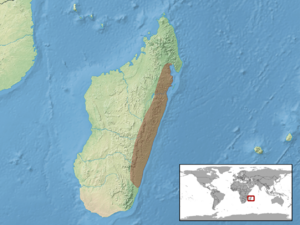Common flat-tail gecko facts for kids
Quick facts for kids Common flat-tail gecko |
|
|---|---|
 |
|
| A giant leaf-tailed gecko on the island of Nosy Mangabe off Madagascar | |
| Conservation status | |
| Scientific classification | |
| Genus: |
Uroplatus
|
| Species: |
fimbriatus
|
 |
|
| Synonyms | |
|
Stellio fimbriatus Schneider, 1797 |
|
The common flat-tail gecko (Uroplatus fimbriatus) is a special kind of gecko. It lives only on the island of Madagascar and some nearby small islands like Nosy Bohara and Nosy Mangabe. These geckos are known for their unique, flat tails that help them blend in. They live in warm, wet rainforests. These amazing lizards can grow quite large, reaching up to 33 centimeters (about 13 inches) long!
What's in a Name?
The name Uroplatus comes from two old Greek words. "Ourá" means "tail," and "platys" means "flat." So, Uroplatus literally means "flat tail." This makes sense because of their super flat tails!
The second part of its name, fimbriatus, is a Latin word. It means "fringed." This refers to the gecko's special skin. It has a unique, fringed edge that helps it disappear against tree bark.
Meet the Flat-Tail Gecko!
This gecko is a large lizard that is nocturnal. This means it is active at night. During the day, it sleeps. It often rests head-down on a small tree trunk. Its amazing camouflage helps it hide perfectly.
These geckos have incredible eyesight. Their eyes are about 350 times more sensitive to light than human eyes! This allows them to see colors even in the dark. This super vision helps them hunt insects and other small creatures at night.
If a flat-tail gecko feels scared, it has a cool way to protect itself. It will raise its tail and head, open its mouth wide, and let out a loud scream! This can surprise predators and give the gecko time to escape.
Why These Geckos Need Our Help
The common flat-tail gecko faces some big challenges. One of the main threats is habitat loss. The rainforests where they live are being cut down. This is called deforestation. When their homes are destroyed, these geckos have nowhere to live.
Another problem is the illegal pet trade. These geckos are very unique and beautiful. Because of this, some people try to catch them and sell them as pets. This is often done illegally. The World Wide Fund for Nature (WWF) has listed Uroplatus geckos as species threatened by this illegal trade.
To help protect them, the common flat-tail gecko is listed under CITES Appendix 2. CITES is an international agreement that helps control the trade of wild animals and plants. Appendix 2 means that trade of these geckos is allowed, but it must be carefully controlled. This helps make sure that enough geckos are left in the wild.
Gallery
-
The underside of the Leaf Tailed Gecko clinging to glass







